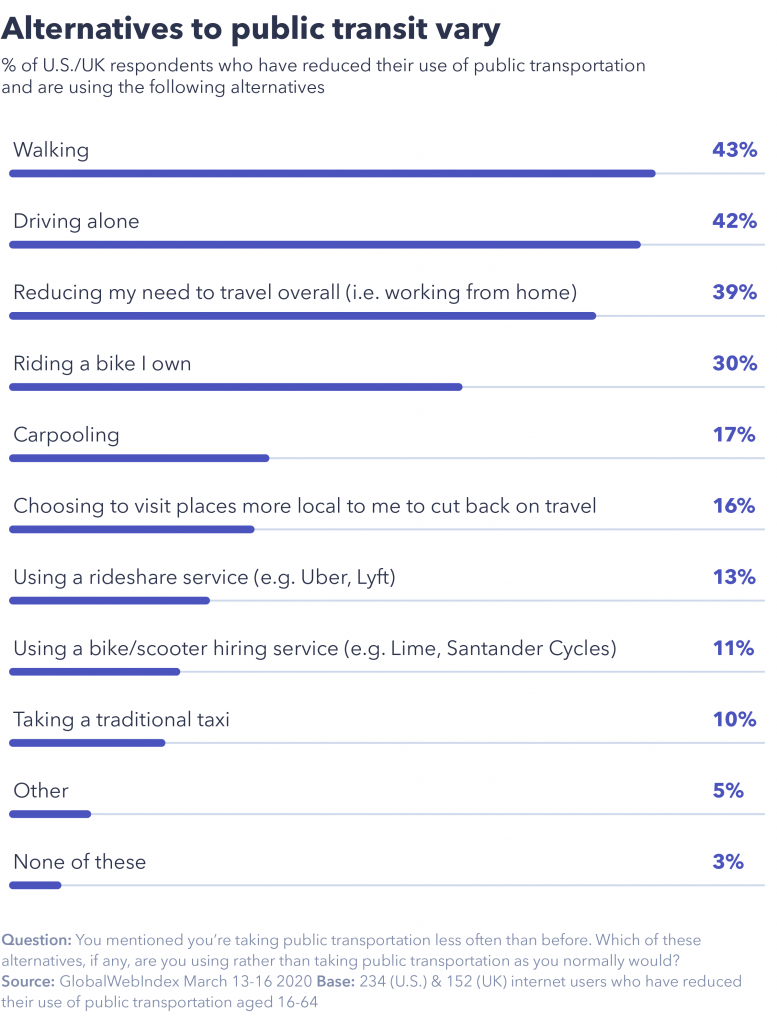With the rapid spread of coronavirus, people all over the world have had to drastically change their lifestyles. The scramble to contain the outbreak has varied from closing bars and restaurants, to enforcing “shelter-in-place” policies, to full-scale lockdowns.
Depending on where you live, the world may seem to have come to a screeching halt. But the reality is that, in many places, people still are making routine journeys.
Read the full report here.
Groceries must be stocked and medication must be picked up. And for a sizable part of the workforce, like delivery people, industrial workers, retail staff, and healthcare professionals – jobs still need to be done.
So how are we navigating transit, in the midst of this global pandemic? Through our very latest dedicated study on the impacts of the COVID-19 outbreak on consumers in the U.S. and UK, we explored exactly this question.
Our research highlights some of the biggest concerns, behavioral changes, and inequities that further come to light when one of our most basic and routine habits – the commute – becomes difficult and potentially harmful.
People are changing their transit behaviors.
Roughly 4 out of 10 U.S. and UK public transit users report that they’ve either stopped or reduced their reliance on public transport since the outbreak.
Driving patterns, however, have not altered so dramatically; only about 1 in 4 drivers have reported a similar cutback on car travel.
For those who normally rely on public transit, they’ve got to get where they’re going somehow. When it comes to alternatives, solitary behaviors dominate – perhaps a credit to the social distancing that people are increasingly taking seriously.
Walking as an alternative to public transportation is the preferred choice, significantly so among those living in urban areas.
People in suburban areas are staying home more than others.
What’s perhaps more surprising is the difference among urban and suburban consumers in choosing to stay home. Reducing the need to travel by working from home, not going out to bars, restaurants, etc. is a behavior that skews heavily suburban.
37% of urbanites, compared to 46% of suburbanites, are replacing their reliance on public transit with staying home more.
And 26% of those living in the suburbs, compared with just 13% of those in cities, are choosing to visit places more local to their area to avoid needing to travel.
Those with higher incomes are more in favor of a total shutdown.
With the high degree of exposure to others that’s innate to public transit, it’s an assumed reality that subways and buses will be the first to clear.
Cities have taken steps to try and make it safer for those who cannot go without using public transportation, however, like the New York MTA’s plan to disinfect subway cars every three days.
And while the media often paints an alarmist picture, consumers are much more likely to say that the right thing to do is simply clean facilities more frequently rather than shut them down.
Across the U.S. and UK, 65% of consumers want their municipal governments to do this – compared with 20% of U.S. consumers and just 13% of UK consumers who think that halting transit is the answer for curbing the outbreak.
This opinion is not shared equally, however. Urban consumers are about as likely as suburban and rural consumers to say that cities should run public transit on modified schedules, and they’re even more likely to favor shutting down public transit.
At first glance this is surprising; urbanities are surely relying on public transportation more than others?
Further interrogation reveals the differences along income lines. Among all consumers, high-income people are 41% more likely than low-income people to favor modifying transit lines, and 29% more likely to support halting public transit entirely. The difference among urbanites is even more stark.
Those with a high income are over twice as likely as those with a low income to favor shutting public transit lines to curb the outbreak.
It’s well known that lower income people are more reliant on public transportation. Times of crisis like this often exacerbate the inequalities within our society, as those with less privilege struggle to find alternatives in a disrupted world. Transit is only one example of this.
A New York Times opinion piece analyzed how working from home is a modern privilege that we, as office-based workers, can take advantage of because of the many people operating in a convenience and delivery economy that supports us. People, organizations, and brands who seek to be good global citizens at this crucial moment would do well to consider this.
Takeaways, online shopping and linear TV is soaring among millennials and younger consumers.
As we increasingly choose – or are encouraged – to stay home rather than take any transit at all, the question of how to fill the many hours becomes pertinent.
So what are people doing? Among younger people, the answer is increasing their media consumption. 79% of millennials and 72% of Gen Zs have changed their lifestyle in at least some way – compared with only 37% of baby boomers.
Consuming more news content is number one overall. But when we look at millennials specifically, their reputation as convenience consumers strikes true.
They’re more than twice as likely to say they’re ordering more takeout vs. any other group, and are also increasing their online shopping and watching more online TV.
For media companies, looking at how consumption of linear TV is increasing will be especially salient. While the curve is always moving toward streaming, the growth is in linear.
36% of respondents overall report an increase in their linear TV watching compared with 24% who have increased their streaming.
Looking at how these content streams balance each other as consumers navigate a new “normal” at home, at least for the next couple of months, will be telling.

